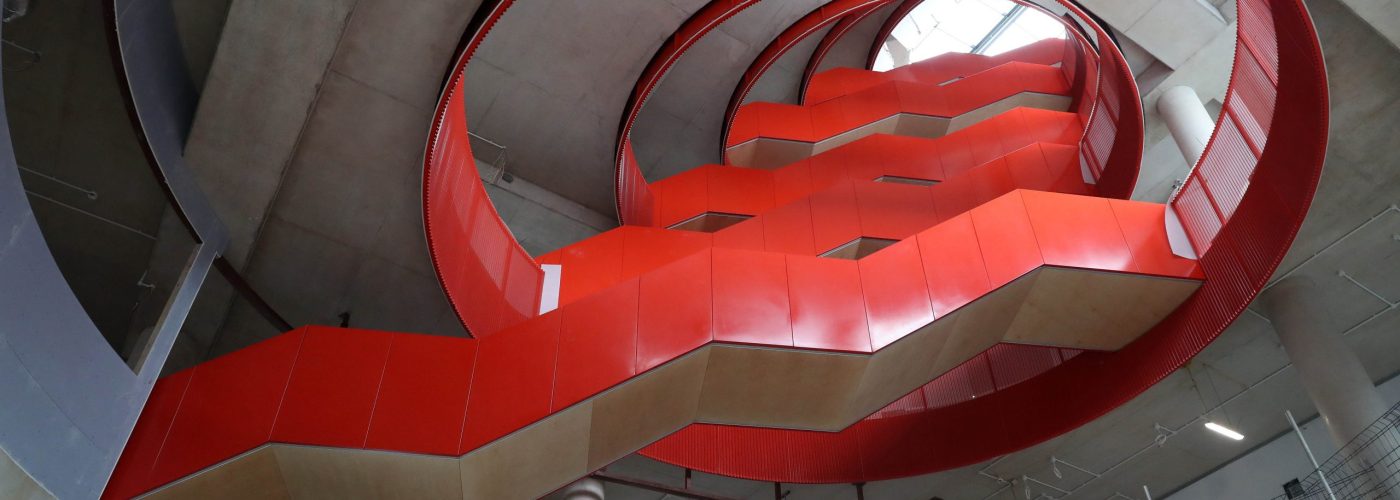The first glimpse of the oculus staircase, the first of its kind in the UK, can be seen following its installation at Cardiff Innovation Campus’ sbarc | spark building.
The finishing of the oculus staircase is a pivotal moment in the construction of the Innovation Campus. The sbarc | spark showpiece starts at the ground floor as a social stair and forms breakout zones to each level which are curated differently, becoming destinations to users on other floors.
Bouygues UK, the construction company building the £300 million state-of-the-art Campus, worked with Taunton Fabrications to design and install the staircase, which was designed by architects Hawkins\Brown.
The staircase is a sculptural, open staircase travelling through a slanting void. Its name is taken from the oculus design, which depicts an eye that allows light to flood into a space. It aims to drive engagement and collaboration between the varying departments and uses of the sbarc | spark building.
The Innovation Campus is being built on the site of a disused rail yard and comprises two buildings. sbarc | spark will be home to the world’s first Social Science Research Park (SPARK), alongside CardiffInnovations@sbarc – Cardiff University’s creative space for start-ups, spinouts and partnerships. The Translational Research Hub will be home to two world-leading scientific research establishments – the Institute for Compound Semiconductors and Cardiff Catalysis Institute.
Mike Baynham, Operations Director for Bouygues UK in Wales, and project lead on Cardiff Innovation Campus, said: “It’s amazing to have witnessed this staircase taking shape over the past few months. The expertise of Taunton Fabrications and the amazing vision of Hawkins\Brown have all come together to create a spectacle in this truly one-of-a-kind building.
“The way the staircase was constructed is also very unique as the stairs weren’t installed directly above each other, as traditionally happens, but are offset at each floor level. Several methods of installation have been reviewed over months to come up with the best way to install the stairs safely and practically.”
Mike explained: “Our great team here at Bouygues UK came up with a solution to install each stair after each floor slab was built and then construct the next floor above the stair with a cleaver configuration. These temporary works was designed by Taunton Fabrications and the RC frame Contractor, 4D Structures. This was then repeated on every floor. It is a complex but exciting construction project and is amazing to see it come to fruition.”
Julia Roberts, Partner and Education & Research Sector Lead of Hawkins\Brown said: “The oculus staircase was designed as a stimulating setting that fosters collaboration between researchers, practitioners and policy-makers. To develop this design, we worked with our computational design team and produced a script that allowed us to create a parametric model of the oculus void for best coordination with structures and M&E design teams. This also enabled us to create a game engine walkthrough which you were able to experience on a VR headset – it proved to be a powerful design development tool which actively involved the University and building users.
“This was the first time we utilised game engine technology on a project, and it’s very rewarding to see it taking shape on site.”
Professor Damian Walford Davies, Pro Vice-Chancellor for the College of Arts, Humanities and Social Sciences, said of the finishing of this milestone in the project: “The oculus is the light-flooded heart of our building: a visible symbol of the connections and configurations between people and projects that this space beautifully enables, as much as a practical thoroughfare.”





